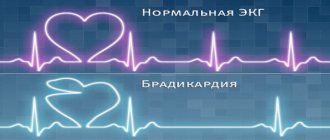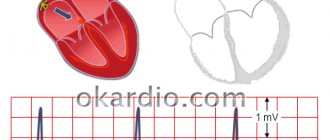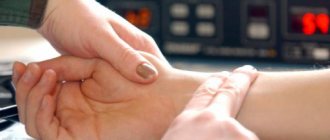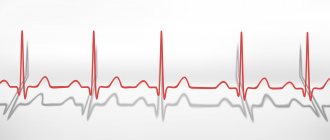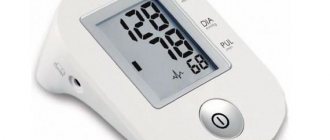For healthy people, a normal heart rate is considered to be 50-90 beats per minute. The number of heartbeats less than this range is called bradycardia, and more - tachycardia. But sometimes bradycardia develops in athletes. Why does this happen, does this condition need to be treated, is it good or bad? What preventive techniques are needed?
Heart reaction to additional stress
Bradycardia and sports often go hand in hand. This is due to the reaction of the heart muscle to constant physical activity. When a person becomes an athlete, transformations occur in his bloodstream. Change gives a person the opportunity to be more resilient and perform more difficult exercises.
Important! As you train, the sinuses of the heart stretch a little. The more the heart muscle is trained, the greater this expansion. When loads are repeated over and over again, pathology develops.
In cases where sports training is at a high level, and bradycardia does not cause any negative symptoms from the cardiovascular system, the pathology does not require special treatment. This is more like the physiological norm for a person with high loads. In this case, most often the organs do not experience a lack of oxygen, since a trained heart is capable of fully supplying the body with nutrients even with rarer contractions.
Symptoms of bradycardia and features of its treatment
Bradycardia is a type of arrhythmia and is characterized by a low heart rate. This diagnosis is made if the heart rate is less than 60 beats per minute. It should be said that such a heart rate is developed in athletes as a result of adaptation to high physical activity and is the norm and a sign of fitness.
Bradycardia is said to be a disease when there are pathologies in the conduction system of the heart and abnormalities in the functioning of the cardiac pacemaker are observed. At the same time, the myocardium cannot work fully and provide organs and tissues with blood, and therefore nutrition. Severe forms of the disease can be life-threatening.
Types of bradycardia
There are several types of bradycardia:
- Absolute. It is always determined, regardless of a person’s condition and the conditions in which he finds himself.
- Relative. This type of bradycardia occurs due to injuries, as a result of physical activity, infectious diseases, and hypothyroidism.
- Moderate. It occurs mainly in adolescents and children, as well as in people with respiratory arrhythmia and high tone of the autonomic nervous system. At the same time, when you inhale, the pulse quickens, and when you exhale, it becomes rare.
- Extracardiac bradycardia. Develops in people with neurological pathologies and diseases of internal organs.
According to localization, types such as sinus bradycardia (the source of the rhythm is the sinoatrial node), as well as sinoatrial and atrioventricular, which occur when there are disturbances in the conduction of impulses between the atria and/or ventricles and the sinus node, are distinguished.
For reasons of development, bradycardia is divided into idiopathic, toxic, central and degenerative.
Signs of bradycardia
Symptoms depend on the duration and severity of the disease and are expressed by the following manifestations:
- Constant fatigue, weakness and weakness, and even full sleep does not help. Possible semi-fainting and fainting states. Such symptoms are associated with a decrease in blood pressure.
- High fatigue even with minor loads.
- Constant dizziness.
- Cold sweat.
- Labored breathing.
- Pressing pain in the chest and trembling of the heart.
- Lightheadedness, darkening of the eyes.
- Absent-mindedness, difficulty concentrating and focusing vision.
- Blood pressure with sinus bradycardia can be unstable: it rises and falls.
- Physical work is difficult.
Manifestations of bradycardia negatively affect the quality of life. Sudden attacks often occur - Morgagni-Adams-Stokes syndrome. After 20 seconds, muscle cramps appear, the pulse becomes very rare or absent, breathing is deep, the skin is pale. The attack can result in death.
With bradycardia, the brain is insufficiently supplied with blood. In severe forms of the disease, symptoms of the myocardium and brain may appear. In addition to fainting, instability of blood pressure, cardiac ischemia, angina at rest and exertion, heart failure, and possible cardiac arrest are observed.
How is the diagnosis made?
Preliminary diagnosis is based on a survey of the patient himself. From his words, the severity and duration of the disease are determined.
The diagnosis of sinus bradycardia is clarified through a series of examinations. One of the most effective methods is ECG. This involves measuring electrical impulses that control the heart rate. You should be aware that signs of bradycardia may periodically appear and disappear, so they are not always detected on the ECG. The disease will be diagnosed if symptoms appear during examination.
Another method for determining bradycardia is a Holter monitor. This is a lightweight, portable device that allows you to monitor cardiac events throughout the day. It is convenient to always carry it with you and monitor your heart rate. This is the most reliable way to diagnose incoming heart rhythm disturbances.
In addition, a laboratory test is carried out: a blood test (biochemical and general) and an analysis of thyroid hormones are prescribed.
A chest x-ray can determine venous congestion in the lungs and the size of the heart shadow.
In addition, methods such as ECHO-CG (ultrasound of the heart), transesophageal examination, bicycle ergometry, coronary angiography, EPI (electrophysiological study) are used.
Features of bradycardia in children and what is its danger?
Everyone knows that the pulse reflects the frequency of oscillations of the heart muscle. A low pulse in a person can indicate the presence of various abnormalities and malfunctions in the functioning of the heart. There are many factors that provoke this condition. These include weather dependence. The pulse may become weak due to medications that lower blood pressure.
Causes of bradycardia
The normal pulse rate for people of different age groups is different; it ranges from 60 to 100 beats per minute. But it cannot be said that a one-time decrease to 50 beats per minute indicates pathology. There are many reasons why values may deviate from the norm. These include:
- disruptions in the functioning of the endocrine system;
- arterial hypertension;
- heart disease;
- bad habits;
- emotional stress;
- heavy physical activity, including sports;
- infectious diseases;
- head injuries;
- long-term use of medications;
- hypothermia;
- significant blood loss;
- long fasting.
The listed reasons affect changes in heart rate. Depending on the provoking factors, the following types of bradycardia can be distinguished:
- Absolute.
- Relative.
- Moderate.
- Extracardiac.
With absolute bradycardia, a weak pulse does not affect the quality of life. The person does not experience any symptoms. Relative bradycardia manifests itself during heavy physical exertion or develops against the background of serious illness. Moderate bradycardia is most often diagnosed in children; a low heart rate appears only during sleep. Treatment varies depending on the type of bradycardia.
In cardiological practice, there is an asymptomatic course of bradycardia. A weak pulse can be detected in an absolutely healthy person with normal blood pressure during a routine medical examination. This is not a life-threatening manifestation, but such a pathology requires observation. With a weak pulse, the following often occur:
- dizziness;
- fainting;
- headache;
- weakness;
- neurological disorders.
Increasing manifestations may indicate irreversible changes in the functioning of the heart; such a condition requires urgent treatment.
But often a low pulse does not cause concern to cardiologists if the blood pressure is normal. This often happens in athletes whose pulse fluctuates within beats per minute, without unpleasant symptoms.
Average patients whose pulse is less than 60 beats per minute often turn to a cardiologist with complaints of weakness, difficulty breathing, and decreased brain activity. This condition requires study to determine the causes.
Particularly dangerous is a rare pulse, the frequency of which is less than 40 beats per minute. This can be critical because the brain is starved of oxygen. This condition is accompanied by nausea and dizziness, in some cases a sudden loss of consciousness.
The most dangerous thing is that the patient's heart may stop, which becomes fatal in the absence of necessary medical care. Pulse rate should be monitored to prevent irreversible consequences.
A rare pulse may be an individual characteristic of the body or a distinctive manifestation of heart disease. If your heart rate is less than 50 beats per minute, you should call an emergency team. If a patient loses consciousness, it is mandatory to be hospitalized. This condition is life-threatening.
In this case, taking medications without a doctor’s prescription is dangerous. In order to select the necessary drug, you should undergo an examination, measure the pressure and frequency of the heart muscle 2 times a day for a week. The following medications are prescribed:
- sympathomimetics;
- anticholinergics.
The use of such drugs should be under the supervision of a physician. In some cases, taking such medications can cause other pathological changes in the heart.
If your heart rate is slightly reduced, you can increase it slightly at home by doing the following:
- relax and unwind;
- drink a glass of green tea;
- take the medication prescribed by your doctor.
Light exercise is also helpful. Some doctors believe that running at an easy pace helps regulate your heart rhythm. The patient is recommended to lead a healthy lifestyle and completely give up bad habits.
Treatment
Treatment is directly related to the causes of the disease. Therefore, it is impossible to choose effective drugs on your own. Combinations of medications are selected by a cardiologist individually for each patient.
There are forms of bradycardia that do not require treatment, in which to normalize the pulse it is only necessary to eliminate negative factors. If bradycardia occurs due to medication, it is enough to change it to a drug that does not affect the heart rate.
A weak pulse often does not pose a threat to human life. But it is worth noting that timely consultation with a doctor is necessary. You should not self-medicate, as it often aggravates the course of the disease and leads to irreversible consequences. Treatment of bradycardia with all kinds of herbs and infusions can only begin after consulting a cardiologist.
Symptoms
Prolonged sinus bradycardia is not a harmless phenomenon. Improper load distribution can cause serious complications.
The pathological form of the disease is accompanied by:
- decreased concentration of attention,
- weakness in the body
- fainting states,
- convulsive lesions,
- pain in the heart area,
- deterioration of vision,
- breathing problems,
- vertigo,
- pale skin.
Why is bradycardia dangerous for adults and children?
Moderate bradycardia does not lead to significant hemodynamic decompensation. But if the number of contractions decreases to 40 beats per minute, then the following clinical signs develop:
- general weakness;
- fainting conditions;
- difficulty breathing;
- decreased vision;
- chest pain;
- decreased ability to concentrate;
- convulsive syndrome.
Pathogenesis of bradycardia
The brain is the most sensitive to oxygen starvation; when blood flow stops, attacks of loss of consciousness develop; if help is not provided in a timely manner, respiratory and cardiac activity stops.
We recommend reading about sick sinus syndrome. You will learn about the causes of SSU, symptoms, classification, diagnosis and treatment. And here is more information about the simultaneous treatment of arrhythmia and bradycardia.
Who is more susceptible to change?
Not all sports lead to the development of bradycardia. The following athletes are at risk for pathology:
- football players,
- skiers,
- speed skaters,
- cyclists,
- track and field athletes.
In second place in terms of the degree of impact on the myocardium are the following sports:
- hockey,
- swimming,
- struggle.
Those who engage in weightlifting rarely suffer from bradycardia. Such training has virtually no effect on the myocardium. The heart does not enlarge and the heart rate does not change even over time.
Important! Significant changes occur only in those who have moderate intensity loads, but constant and regular ones.
Good and bad sports
If you have bradycardia, it is not recommended to engage in the following sports:
- skis when skating;
- cycling;
- football;
- skates;
- Athletics.
The following sports are allowed:
- swimming;
- hockey;
- golf;
- rowing;
- sports wrestling.
Is sport acceptable for pathology?
Some people suffer from bradycardia and other cardiovascular diseases. Are any sports activities really contraindicated when such a diagnosis is made?
Regardless of how heavy the load is planned, careful medical supervision is necessary. If you carefully monitor your well-being, you can always provide timely, high-quality assistance and apply appropriate treatment. Bradycardia itself is not considered a contraindication to sports.
If the patient's condition is not controlled, concomitant pathologies may develop. It is important to have an annual inspection.
Sinus bradycardia in athletes - what is it?
Bradycardia is usually called a violation of the automaticity of the sinus node, in which the heart rate slows down, i.e. heart rate decreases. If the pulse is normally 60 beats/min, then with bradycardia it decreases noticeably . As a result, blood circulation worsens and oxygen supply to tissues decreases.
Sports bradycardia is an adaptation of the heart to frequent, prolonged and intense physical activity experienced by a person who is professionally involved in sports. So the heart, adapting to regular changes in energy balance, switches to an economical mode of operation. Why does this phenomenon occur?
At the beginning of intense training and in poorly trained people, when significant physical activity occurs, the body feels a lack of oxygen, causing the heart to contract more intensely. Temporary tachycardia appears. After rest, everything returns to its previous state.
If a person plays sports professionally, these loads become regular, and the body does not have time to fully recover. Such training leads to an increase in the heart muscle (myocardium) and expansion of the heart cavities. At a certain stage, an additional vascular network is formed in the myocardium, which makes it possible to increase the release of blood per contraction. As a result of the changes occurring, the volume of a single blood ejection increases, which provides an increase in blood supply without increasing the heart rate .
Thus, intense physical activity leads to the formation of the so-called “athletic heart”. It has an increased volume with an additional compensatory capillary network approaching the myocardium. This “pump” pumps more blood, which means the heart rate decreases without harming the entire system.
What is a “sports heart”, is it the norm or a dangerous deviation, watch the video:
Good or bad?
To answer the question whether sports bradycardia is dangerous, it is necessary to understand the difference between the physiological and pathological “sports” heart formed as a result of bradycardia. In the first case, the changes can be considered useful, because they allow the heart to work normally even under excessive stress. In the second case, you can expect serious troubles due to the risk of functional impairment.
The physiological heart has a volume of no more than 1250 cc . It ensures complete blood circulation at a heart rate of less than 60 beats/min without physical exertion. When an intense load appears for a short time (up to 30 s), tachycardia appears (up to 180-200 beats/min), but compensation circuits quickly “turn on” and heart contraction stabilizes.
During prolonged sports activity, the heart rate is maintained within normal limits, which allows the body to work in extreme conditions. After the necessary rest, everything returns to its original position.
Thus, in most cases, sports bradycardia protects the body from overload and has a beneficial effect. Moreover, the physiological heart is a reversible change. If a person stops playing professional sports, the organ gradually returns to its normal state.
A pathological heart leads to irreversible changes and can cause serious health problems.
Its main symptom is excessive expansion of the organ - a volume of more than 1300 cubic meters. cm (in some circumstances up to 1750 cc).
Excessive enlargement of the heart muscle leads to a deterioration in its functioning due to deterioration of blood supply and oxygen starvation of muscle fibers. There is a risk of necrosis of muscle tissue, up to microinfarction, as well as the development of cardiosclerosis.
The reasons for the formation of a pathological heart are improper training process, the presence of heart diseases, chronic diseases of other organs and various infections. Read more about the reasons that contribute to the appearance of bradycardia here.
When is treatment needed?
The formation of a pathological heart requires medical intervention. It is not always possible to distinguish it externally from the physiological state. Alarming signs include lack of adaptation to training loads, the appearance of insomnia, and rapid fatigue.
Dangerous symptoms are a decrease in heart rate below 45 beats/min at rest, fainting, shortness of breath, dulling of visual acuity and decreased attention. If such manifestations are present, the necessary examination by a cardiologist should be carried out.
To diagnose dangerous sports bradycardia, the following methods are used:
ECG . Foci of impaired blood supply to the myocardium and changes in conductivity are determined. Treadmill . The technique is based on conducting an ECG during exercise on a treadmill. It allows you to assess a person’s ability to withstand various sports loads. Ejection fraction research .
Blood ejection from the left ventricle during systole is assessed. For analysis, special calculations are carried out based on the results of cardiac ultrasound. A release of less than 45 percent is considered pathological. A level of about 30 percent indicates the development of heart failure. If a risk of pathological changes is detected, treatment is necessary. Its tactics depend on the degree of bradycardia.
In case of moderate manifestations, a special warm-up regime is introduced before sports activities and medical supervision. When obvious signs of a pathological heart appear, medications are prescribed that increase the heart rate (Atropine, Platiphylline, Belloid, etc.).
In case of severe arrhythmia, cardiac pacing is indicated. A particularly dangerous condition is when valve insufficiency develops as a result of myocardial hypertrophy. With this complication, surgical treatment to correct the valves is possible.
In our time, the most modern and accurate techniques are used to diagnose the functioning of the heart. ECG is one of the proven and reliable methods. We invite you to learn a lot of useful and important information on this topic:
How are impulses formed?
The heart rate is controlled by the sinus node. It is here that the impulse is formed that causes the heart to contract. Normally, a healthy person's pulse is 60-80 beats at rest. The heart muscle works as economically as possible, while fully providing all organs with oxygen.
During high physical activity, a new network of small blood vessels is formed near the heart. This provides additional nutrition to the myocardium. Thanks to this, even with rarer contractions, the body has time to receive the necessary nutrients.
Low heart rate in a trained person: is it good or bad?
Athletes are characterized by a slow heart rate due to high cardiac training.
Regular sports activity in an athlete leads to the fact that the heart muscle becomes denser and therefore requires more oxygen to ensure normal functioning. The deficiency is compensated by an increased heart rate. The heart pumps a larger volume of blood, which helps prevent tissue hypoxia. Over time, the vascular system transforms and provides maximum oxygen flow even with increasing stress.
In experienced athletes, in a calm state, the heart slows down, and during physical activity, the contraction frequency increases sharply (up to 260 beats per minute) to more effectively adapt to stress and supply muscles with oxygen. This is their advantage over beginners. Professionals have a well-developed network of capillaries, which, gradually growing, promotes blood supply and nutrition to the hypertrophied myocardium.
However, if the heart size exceeds 1200 cubic meters. cm, a transition to malignant hypertrophy is likely, creating a number of complications in the absence of medical control.
If training is not structured correctly and the load exceeds the functional capabilities of the body, as well as with concomitant diseases, pathological changes occur in the heart. The faster the heart cells grow, the worse the blood supply to the newly formed areas.
Vascular and nerve cells grow more slowly than muscle cells. Because of this, hypoxia and energy starvation develop. They lead to tissue necrosis - myocardial infarction, with all the ensuing consequences: scarring and possible complications. The sad result of this process is cardiosclerosis and the inability to reach sporting heights in the future.
When is bradycardia a sign of pathology?
Even among athletes, signs of pathology are not always harmless. In some cases, a slow heartbeat can cause negative symptoms.
Prolonged bradycardia with negative consequences can develop with an improper increase in sports loads. Although the sinuses of the heart will gradually increase in size, the performance of the organ will not correspond to normal.
With pathological bradycardia, unpleasant symptoms begin to appear:
- dizziness,
- oxygen starvation,
- pale skin,
- malfunctions of various organs.
In severe forms of bradycardia, even in athletes, heart function may deteriorate. It is possible to develop focal cardiosclerosis, when areas of the heart stop performing their functions and are replaced by connective tissue.
Action tactics and observation of the athlete
Bradycardia is a decrease in the frequency of contraction of the heart muscle to 60 beats or lower. And if in untrained people the decrease causes a number of unpleasant symptoms, then the athlete’s body “adjusts” after regular training and bradycardia becomes the norm. Under the influence of regular physical activity, a number of changes begin in the organs of the cardiovascular system - blood circulation is transformed and the volume of the heart increases (myocardial hypertrophy). Correct loads on the heart ensure high performance of the athlete: the organ works calmly under high load.
Enter your pressure
Move the sliders
A low, regular heart rate in athletes is called "athlete's heart syndrome." It is often recorded in professional athletes, as well as in people who engage in sports for a long time (more than an hour a day). This is how the body adapts to stress. Despite its “physiological” nature, this condition can mask serious health problems.
In adolescent athletes, bradycardia is often associated with changes in the cardiovascular system and also requires monitoring.
Most often, bradyarrhythmia is a consequence of active (more than 5 hours per week) aerobic exercise; less often it occurs when performing static exercises, for example, when lifting weights. During intense, long-term exercise, the heart pumps more blood to meet the increased oxygen demands of skeletal muscles.
Symptoms when bradycardia worsens to 40 beats per minute are as follows:
- Weakness.
- Dizziness.
- Fast fatiguability.
- Chest pain.
- Dyspnea.
- Deterioration of vision.
- Headache.
- Feeling short of air.
- Panic attacks.
- Anxiety.
- Inability to concentrate.
The clinical picture is nonspecific and may indicate another cardiac pathology, so it is recommended to immediately seek medical help.
To diagnose and differentiate sinus bradycardia in athletes, the same methods are used as for other categories of patients:
- Survey.
- General clinical tests.
- General examination – palpation, percussion, auscultation, pulse measurement.
- Electrocardiography.
- Holter 24-hour monitoring.
- Ultrasound of the heart.
- Stress load test.
If malignant bradycardia is not diagnosed in time and treatment is not started, then even in the absence of complaints, the following serious complications may occur:
- Heart failure.
- Cerebrovascular accident.
- Chronic heart failure.
- Progression of coronary heart disease.
- Acute myocardial infarction.
- Cardiomyopathies.
- Formation of acquired heart defects (mainly valve insufficiency).
If complications develop, exercise should be postponed until the recovery period. The doctor will determine the functional capabilities of the body and select proportionate loads.
For non-professional athletes, playing sports maintains health and prolongs life. But in professional sports, where exhausting physical activity is indispensable, athletes can develop negative conditions and heart disease.
Bradycardia in athletes is one of these conditions, which is considered normal up to a certain point, but often turns into a pathological form.
Normal heart rate in an adult is 50-90 per minute. If the number of contractions is in a smaller range, then this is bradycardia. Parameters greater than normal are called tachycardia.
Bradycardia is observed in professional sports and representatives of such sports as:
- football,
- skis,
- skates,
- bike,
- Athletics.
Hockey, swimming, and wrestling are less dangerous in relation to the development of bradycardia.
Interesting! Weightlifters practically do not suffer from bradycardia, since the specific training does not affect the myocardium and does not affect the heart rate.
Regular physical training leads to thickening of the muscle fibers of the heart, which requires a more intense supply of oxygen to them. In such a situation, the work of the heart is compensated by tachycardia.
But with further thickening of the heart muscle, a compensatory branched vascular network develops in it, capable of supplying the heart with blood in full even under heavier loads.
With such a constructive modification, the increase in heart rate is irrational, and athletes develop sinus bradycardia - a noticeable decrease in the heart rate. The heart switches to an economical mode of operation: more rare, but more powerful contractions. With increasing physical activity, the heart rate increases from 2 to 5 times.
note
After the load is reduced, it returns to its original state. A heart capable of working in this mode is called physiologically athletic.
It ensures normal blood supply to all organs and systems, normal functioning of the body as a whole.
If the heart grows too intensively, then a pathological athlete’s heart develops, which is characterized by the following symptoms:
- low heart rate,
- weak muscle contractility of the heart,
- high hypertrophy of the heart muscle,
- changes in the conductivity and rhythm of the heart muscle,
- replacement of muscle fibers with connective tissue, which leads to cardiosclerosis and functional heart failure.
Bradycardia leads to the development of structural changes in the heart muscle - the myocardium. If this condition becomes pathological, then the heart increases significantly (reaching a volume of up to 1500 cm3). Even an enlarged circulatory network cannot fully provide such a heart with nutrition and oxygen.
This leads to a decrease in its functionality, which in turn leads to the development of necrosis of areas of the heart muscle - ischemia and myocardial infarction. Dead, non-functional muscle fibers are replaced by connective tissue, forming scars.
Electrical nerve impulses do not pass through such tissue, which leads to arrhythmia, chaos in the rhythm of the heart. This condition requires urgent treatment, elimination of all physical activity, and a change in the athlete’s lifestyle.
Danger occurs when the heart rate drops to 40 beats per minute. Clinical symptoms develop:
- constant fatigue and weakness,
- fainting,
- dyspnea,
- decreased visual acuity,
- inability to concentrate,
- convulsive syndrome.
The brain is especially sensitive to a lack of oxygen in the blood. Limited access of blood to it leads to loss of consciousness and cardiac arrest.
An adjusted load does not harm a healthy body; on the contrary, it is the key to good health. Sports activities also have a positive effect, provided that the load is not excessive.
But heavy physical activity, mandatory in professional sports, negatively affects the health of the cardiovascular system and the body as a whole.
Thus, bradycardia develops in a physiological or pathological form. If the latter is stated, one will have to forget about professional sports.
For athletes with this pathology, there are recommendations that are worth paying attention to:
- Carrying out regular monitoring of the condition of the heart and vascular system.
- Timely diagnosis of pathology in its early stages of development.
- Adjustment of loads and lifestyle.
A decrease in heart rate is not an obstacle to exercise if it is not accompanied by negative consequences.
What sports can you do?
Sports with heavy training are contraindicated. Conversely, optimally selected cardio loads in race walking, running, swimming, cycling are unlikely to lead to negative consequences in the functioning of the myocardium.
These types of physical activity are accompanied by contraction of different muscle groups, activate blood circulation in the myocardium, improve its functioning - the conduction of impulses and the rhythm of contractions.
Important
You can jog 3-4 times a week for half an hour. Before running, you need to warm up and warm up your muscles. At the end of the run, you need to do muscle relaxation exercises.
You should approach training in the gym with caution. Exercise machines are aimed at increasing muscle strength due to their static tension. Tight muscles pinch blood vessels, and the heart has to work harder to push blood through them.
Exercises with sudden muscle strain when lifting barbells, weights, or performing jerks with heavy sports equipment are not recommended. There is a risk of a sharp disruption of blood flow, including rupture of blood vessels and other complications.
Bradycardia in children
Signs of bradycardia can be observed at different ages, starting from birth. Children who have been diagnosed with bradycardia of various etiologies should be under the supervision of pediatricians and pediatric cardiologists.
The causes of bradycardia in children can be hereditary and acquired factors. Just like in adults, it can be pathological and physiological in nature.
Physiological bradycardia does not need correction, but the child must be under constant supervision by parents and doctors.
A decrease in heart rate is due to sports, active games and other types of vigorous activity (sport dancing, circus studios, etc.). This condition is adaptive to long-term and systematic physical activity.
Having adapted to certain operating conditions, the heart, due to the increased volume of the lungs, does not contract with high frequency. And this condition is considered normal.
Symptoms of pathological bradycardia are invisible for a long time. She begins to manifest herself with unconditional weakness, constant fatigue, drowsiness, and attacks of dizziness. The child may faint during lessons.
Symptoms of bradycardia include shortness of breath, inability to withstand normal exercise in physical education classes, cold sweat, and pale skin. Such symptoms cannot be ignored; the child must be examined by a cardiologist.
Advice
For pathological bradycardia in children, specialized cardiac care is required. Participation in accessible sports is possible only after treatment and rehabilitation, with the recommendations of the attending physician.
What to watch out for when playing sports
Bradycardia in athletes is considered commonplace. The norm for sports enthusiasts is 50-60 beats per minute. If a person has a trained heart, he will not suffer from:
- fatigue,
- dizziness,
- heart pain,
- other symptoms of bradycardia.
Athletes with pathological processes in the myocardium require a special regime and strict medical supervision.
Diagnostics
The main task of the heart is to contract at a certain frequency, carrying oxygen and nutrients with the blood flow to the organs. Blood is an important transporter of vital elements from the heart muscle throughout the body.
The patient may not even be aware that he has a disease such as bradycardia. Symptoms may include loss of consciousness of varying severity. Prolonged ignoring of such manifestations can lead to serious complications and death.
Before a person loses consciousness, they may not experience any significant sensations or symptoms, compared to, for example, an epileptic attack. But it is possible that minor seizures may occur.
A patient with bradycardia may blush before an approaching attack or, on the contrary, become very pale. Beads of sweat may appear. This condition is not always given a clear diagnosis, since the patient himself does not listen carefully to his body and does not seek medical help in a timely manner.
Mechanism of development of bradycardia
Regular physical training leads to thickening of the muscle fibers of the heart, which requires a more intense supply of oxygen to them. In such a situation, the work of the heart is compensated by tachycardia. But with further thickening of the heart muscle, a compensatory branched vascular network develops in it, capable of supplying the heart with blood in full even under heavier loads.
With such a constructive modification, the increase in heart rate is irrational, and athletes develop sinus bradycardia - a noticeable decrease in the heart rate. The heart switches to an economical mode of operation: more rare, but more powerful contractions. With increasing physical activity, the heart rate increases from 2 to 5 times. After the load is reduced, it returns to its original state. A heart capable of working in this mode is called physiologically athletic.
It ensures normal blood supply to all organs and systems, normal functioning of the body as a whole.
If the heart grows too intensively, then a pathological athlete’s heart develops, which is characterized by the following symptoms:
- low heart rate;
- weak muscle contractility of the heart;
- high hypertrophy of the heart muscle;
- changes in the conductivity and rhythm of the heart muscle;
- replacement of muscle fibers with connective tissue, which leads to cardiosclerosis and functional heart failure.



